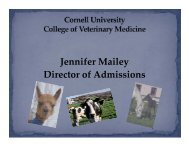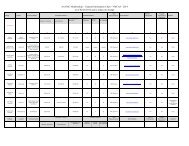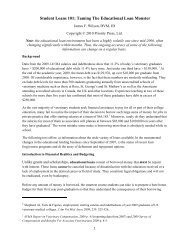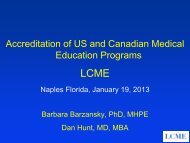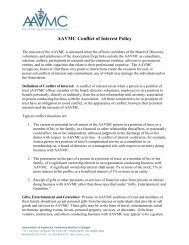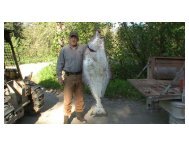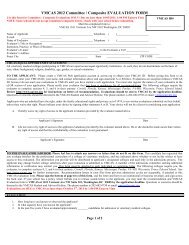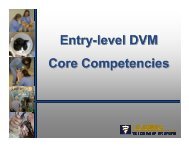Draft Dec 30, 2012 Health and Wellness for Our Students – The ...
Draft Dec 30, 2012 Health and Wellness for Our Students – The ...
Draft Dec 30, 2012 Health and Wellness for Our Students – The ...
Create successful ePaper yourself
Turn your PDF publications into a flip-book with our unique Google optimized e-Paper software.
physicians in the first year of their independent career, we may find that depression thatoriginates in veterinary school persists into the individuals career.Bridging the gap between student expectations <strong>and</strong> their experiences“Research in psychology has indicated that the expectations an individual brings to a situationsignificantly influence how he or she experiences <strong>and</strong> copes with that situation” (LA Pervin,reality <strong>and</strong> non-reality in student expectations of college. J Psych 61:41-48, 1966). Stress is aninevitable part of the veterinary student experience because of the intensity of the curriculum<strong>and</strong> minimal control of the workload. However, there are disconnects noted between student<strong>and</strong> faculty expectations that may exacerbate the stress of veterinary school. First year studentsreport stress associated with the intensity of the program, the required time commitment, theamount of in<strong>for</strong>mation to learn, the amount of material to memorize <strong>and</strong> the paucity ofclinically relevant experiences (7,19). Anxiety <strong>and</strong> depression were both associated with theperception of unclear faculty expectations by students across all 4 years (23). A studycomparing the expectations of 1 st year veterinary students <strong>and</strong> faculty found that (8):• <strong>Students</strong> expected their veterinary education to provide basic competence in veterinarymedicine <strong>and</strong> also train them in specific skills <strong>and</strong> knowledge that would enable them tofunction competently. Training in technical skills was rated very high. <strong>Students</strong> wantedexaminations that integrated facts <strong>and</strong> skills.• Faculty saw a general education that emphasized theoretical basic knowledge where theprimary focus was learning basic facts. <strong>The</strong>y felt that training in technical skills wouldoccur primarily after graduation. Faculty wanted examinations to ensure students hadmastered the in<strong>for</strong>mation.<strong>Students</strong> studied in a surgical education environment noted that anxiety was counterproductiveto learning while excitement appeared to increase their engagement (21). Being able to preparewell was associated with a positive experience while lack of self-confidence accentuated anegative response (21). Are there mechanisms we can improve upon to provide ongoingfeedback that rein<strong>for</strong>ces student perceptions of skills <strong>and</strong> knowledge gained? Can we provideincreased practice periods, ability to gain <strong>and</strong> test skills in different <strong>for</strong>mats?Availability of counseling <strong>and</strong> psychologic services <strong>for</strong> veterinary studentsIn 2001, only 48% of veterinary schools had exclusive counseling services <strong>for</strong> veterinarystudents, <strong>and</strong> most of this was available through part time counselors with an average of 9hours / week (10). In <strong>2012</strong>, the rates <strong>for</strong> in-house counseling support were similar with availabletime varying from 5-40 hours per week (24). Types of services included individual counseling(100%), group counseling (82%), family counseling (69%), stress management (94%),biofeedback (33%), <strong>and</strong> test anxiety reduction (94%). Financial support <strong>for</strong> these came from thecollege (50%), university (19%), or were shared between the college <strong>and</strong> the university (31%).Despite the funding concerns there was a perceived need by colleges: 63% answered that theysometimes needed these services, 27% reported that they needed these services fairly often,<strong>and</strong> 7% reported very often.5



